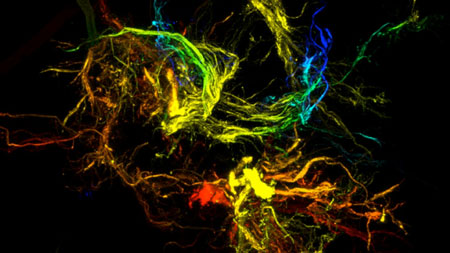| Oct 14, 2019 | |
Unique sticky particles formed by harnessing chaos(Nanowerk News) New research from North Carolina State University shows that unique materials with distinct properties akin to those of gecko feet - the ability to stick to just about any surface - can be created by harnessing liquid-driven chaos to produce soft polymer microparticles with hierarchical branching on the micro- and nanoscale. |
|
| The findings, described in the journal Nature Materials ("Soft dendritic microparticles with unusual adhesion and structuring properties"), hold the potential for advances in gels, pastes, foods, nonwovens and coatings, among other formulations. | |
 |
|
| NC State researchers use a chaotic technique to create ordered particles with sticky properties. (Image: Orlin Velev, NC State University) | |
| The soft dendritic particle materials with unique adhesive and structure-building properties can be created from a variety of polymers precipitated from solutions under special conditions, says Orlin Velev, S. Frank and Doris Culberson Distinguished Professor of Chemical and Biomolecular Engineering at NC State and corresponding author of the paper. | |
| "We use 'liquid' nanomanufacturing to convert most polymers into branched particles after dissolving the polymer and mixing the solution rapidly with another liquid," he said. "This rapid mixing in turbulent flow creates branched particles organized in a hierarchical way." | |
| The thinnest branches surrounding these particles form a corona of nanofibers, Velev added, that distributes their stickiness by molecular forces of attraction known as van der Waals forces. | |
| The new material is unique not only in its structure, but also in the way it is fabricated. | |
| "The use of turbulent flow is ordinarily not known as a way to fabricate organized structures," Velev said. "Here, we are using this inherently chaotic process to create hierarchical structures." | |
| The liquid process used to create these materials works with many types of polymers and is generally efficient and inexpensive. Velev added that the fabrication process can be easily scaled up to produce large amounts of the soft nanomaterial, which is often a challenge for making materials at the micro- and nanoscale. | |
| Future research in Velev's lab will seek to detail the fundamentals behind this surprising finding. Research will also examine the different types of polymer and biopolymer materials that can be created using the process, including coatings and sheets that attract or repel water, for example, or cell scaffolds and 3-D printing pastes. NC State has filed a patent on the new soft dendritic materials and the process for creating them. | |
| "This work is an illustration of how fundamental and applied science can work synergistically," said Simeon Stoyanov, a research collaborator and co-author of the paper. "We started with fundamental scientific findings and while investigating them we found many new applications such as super-adhesives and coatings, which in turn brought new fundamental questions regarding their properties." |
| Source: North Carolina State University | |
|
Subscribe to a free copy of one of our daily Nanowerk Newsletter Email Digests with a compilation of all of the day's news. |
